An Investigation of the Fengyun-4A/B GIIRS Performance on Temperature and Humidity Retrievals
Abstract
:1. Introduction
2. Materials and Methods
2.1. Materials
2.1.1. The FY-4A/B GIIRS Data
2.1.2. Radiative Transfer Model
2.1.3. Dataset
2.1.4. Observation Error
2.2. Methods
2.2.1. Channel Selection Method
2.2.2. Retrieval Method
3. Results and Discussion
3.1. Channel Selection
3.2. Retrieval
3.2.1. Temperature and Humidity Retrievals
3.2.2. Retrieval Comparison
3.2.3. Perturbation Analysis
4. Conclusions
Author Contributions
Funding
Institutional Review Board Statement
Informed Consent Statement
Data Availability Statement
Acknowledgments
Conflicts of Interest
References
- Huang, P.; Guo, Q.; Han, C.; Zhang, C.; Yang, T.; Huang, S. An improved method combining ANN and 1D-Var for the retrieval of atmospheric temperature profiles from FY-4A/GIIRS hyperspectral data. Remote Sens. 2021, 13, 481. [Google Scholar] [CrossRef]
- Sun, J.; McColl, K.A.; Wang, Y.; Rigden, A.J.; Lu, H.; Yang, K.; Li, Y.; Santanello, J.A. Global evaluation of terrestrial near-surface air temperature and specific humidity retrievals from the Atmospheric Infrared Sounder (AIRS). Remote Sens. Environ. 2021, 252, 12. [Google Scholar] [CrossRef]
- Chung, E.S.; Soden, B.J. Investigating the influence of carbon dioxide and the stratosphere on the long-term tropospheric temperature monitoring from HIRS. Am. Meteorol. Soc. 2016, 33, 1967–1984. [Google Scholar] [CrossRef]
- Liu, H.L.; Tang, S.H.; Hu, J.Y.; Zhang, S.; Deng, X. An improved physical split-window algorithm for precipitable water vapor retrieval exploiting the water vapor channel observations. Remote Sens. Environ. 2017, 197, 366–378. [Google Scholar] [CrossRef]
- Von Clarmann, T.; Degenstein, D.A.; Livesey, N.J.; Bender, S.; Braverman, A.; Butz, A.; Compernolle, S.; Damadeo, R.; Dueck, S.; Eriksson, P.; et al. Overview: Estimating and reporting uncertainties in remotely sensed atmospheric composition and temperature. Atmos. Meas. Tech. 2020, 13, 4393–4436. [Google Scholar] [CrossRef]
- Cai, X.; Bao, Y.; Petropoulos, G.P.; Lu, F.; Lu, Q.; Zhu, L.; Wu, Y. Temperature and humidity profile retrieval from FY4-GIIRS hyperspectral data using artificial neural networks. Remote Sens. 2020, 12, 1872. [Google Scholar] [CrossRef]
- Aires, F.; Chédin, A.; Scott, N.A.; Rossow, W.B. A regularized neural net approach for retrieval of atmospheric and surface temperatures with the IASI instrument. J. Appl. Meteorol. 2002, 41, 144–159. [Google Scholar] [CrossRef]
- Dong, C.; LI, J.; Zhang, P. The Principle and Application of Satellite Hyperspectral Infrared Atmospheric Remote Sensing; Science Press: Beijing, China, 2013; pp. 2–9. [Google Scholar]
- Zeng, Q. The Principle of Atmospheric Infrared Remote Sensing; Science Press: Beijing, China, 1974; pp. 15–23. [Google Scholar]
- Wang, F.; Li, J.; Schmit, T.J.; Ackerman, S.A. Trade-off studies of a hyperspectral infrared sounder on a geostationary satellite. Appl. Opt. 2007, 46, 200–209. [Google Scholar] [CrossRef]
- Chang, S.; Sheng, Z.; Du, H.; Ge, W.; Zhang, W. A channel selection method for hyperspectral atmospheric infrared sounders based on layering. Atmos. Meas. Tech. 2020, 13, 629–644. [Google Scholar] [CrossRef] [Green Version]
- Osei, M.A.; Amekudzi, L.K.; Ferguson, C.R.; Danuor, S.K. Inter-comparison of AIRS temperature and relative humidity profiles with AMMA and DACCIWA radiosonde observations over West Africa. Remote Sens. 2020, 12, 2631. [Google Scholar] [CrossRef]
- Zhang, L.; Wei, C.; Liu, H.; Jiang, H.; Lu, X.; Zhang, X.; Jiang, C. Comparison analysis of global methane concentration derived from SCIAMACHY, AIRS, and GOSAT with surface station measurements. Int. J. Remote Sens. 2020, 42, 1823–1840. [Google Scholar] [CrossRef]
- Aumann, H.H.; Chahine, M.T.; Gautier, C.; Goldberg, M.D.; Kalnay, E.; McMillin, L.M.; Revercomb, H.; Rosenkranz, P.W.; Smith, W.L.; Staelin, D.H.; et al. AIRS/AMSU/HSB on the Aqua mission: Design, science objective, data products, and processing systems. IEEE Trans. Geosci. Remote Sens. 2003, 41, 253–264. [Google Scholar] [CrossRef] [Green Version]
- Heng, Z.; Jiang, X. An assessment of the temperature and humidity of atmospheric infrared sounder (AIRS) v6 profiles using radiosonde data in the Lee of the Tibetan Plateau. Atmosphere 2019, 10, 394. [Google Scholar] [CrossRef] [Green Version]
- Xiong, X.; Liu, X.; Wu, W.; Knowland, K.E.; Yang, F.; Yang, Q.; Zhou, D.K. Impact of stratosphere on cold air outbreak: Observed evidence by CrIS on SNPP and its comparison with models. Atmosphere 2022, 13, 876. [Google Scholar] [CrossRef]
- Wang, T.; Zhou, L.; Tan, C.; Divakarla, M.; Pryor, K.; Warner, J.; Wei, Z.; Goldberg, M.; Nalli, N.R. Validation of near-real-time NOAA-20 CrIS outgoing longwave radiation with multi-satellite datasets on broad timescales. Remote Sens. 2021, 13, 3912. [Google Scholar] [CrossRef]
- Yin, M. Assessing the sun glint effect on the data bias of CrIS shortwave surface channels near 3.7 μm. Int. J. Remote Sens. 2016, 37, 356–369. [Google Scholar] [CrossRef]
- Dolgii, S.I.; Nevzorov, A.A.; Nevzorov, A.V.; Romanovskii, O.A.; Kharchenko, O.V. Comparison of ozone vertical profiles in the upper troposphere–stratosphere measured over Tomsk, Russia (56.5° N, 85.0° E) with DIAL, MLS, and IASI. Int. J. Remote Sens. 2020, 41, 8590–8609. [Google Scholar] [CrossRef]
- Masiello, G.; Matricardi, M.; Serio, C. The use of IASI data to identify systematic errors in the ECMWF forecasts of temperature in the upper stratosphere. Atmos. Chem. Phys. 2011, 11, 1009–1021. [Google Scholar] [CrossRef] [Green Version]
- Crevoisier, C.; Clerbaux, C.; Guidard, V.T.; Phulpin, T.; Armante, R.; Barret, B.; Camy-Peyret, C.; Chaboureau, J.-P.; Coheur, P.-F.; Crépeau, L.; et al. Towards IASI-New Generation (IASI-NG): Impact of improved spectral resolution and radiometric noise on the retrieval of thermodynamic, chemistry and climate variables. Atmos. Meas. Tech. 2014, 7, 4367–4385. [Google Scholar] [CrossRef] [Green Version]
- Coopmann, O.; Fourrie, N.; Guidard, V. Analysis of MTG-IRS observations and general channel selection for numerical weather prediction models. Q. J. R. Meteorol. Soc. 2022, 148, 1864–1885. [Google Scholar] [CrossRef]
- Lu, F.; Zhang, X.; Chen, B.; Liu, H.; Wu, R.; Hai, Q.; Feng, X.; Li, Y.; Zhang, Z. FY-4 geostationary meteorological satellite imaging characteristics and its application prospects. J. Mar. Meteorol. 2017, 37, 1–12. [Google Scholar]
- Zhang, Y.; Li, J.; Li, Z.; Zheng, J.; Wu, D.; Zhao, H. FENGYUN-4A advanced geosynchronous radiation imager layered precipitable water vapor products’ comprehensive evaluation based on quality control system. Atmosphere 2022, 13, 290. [Google Scholar] [CrossRef]
- Li, S.; Hu, H.; Fang, C.; Wang, S.; Xun, S.; He, B.; Wu, W.; Huo, Y. Hyperspectral Infrared Atmospheric Sounder (HIRAS) atmospheric sounding system. Remote Sens. 2022, 14, 3882. [Google Scholar] [CrossRef]
- Di, D.; Li, J.; Han, W.; Yin, R. Geostationary hyperspecral infrared sounder channel selection for capturing fast-changing atmospheric information. IEEE Trans. Geosci. Remote Sens. 2021, 60, 4102210. [Google Scholar]
- Irion, F.W.; Kahn, B.H.; Schreier, M.M.; Fetzer, E.J.; Fishbein, E.; Fu, D.; Kalmus, P.; Wilson, R.C.; Wong, S.; Yue, Q. Single-footprint retrievals of temperature, water vapor and cloud properties from AIRS. Atmos. Meas. Tech. 2018, 11, 971–995. [Google Scholar] [CrossRef] [Green Version]
- Andrey-Andres, J.; Fourrie, N.; Guidard, V.; Armante, R.; Brunel, P.; Crevoisier, C.; Tournier, B. A simulated observation database to assess the impact of the IASI-NG hyperspectral infrared sounder. Atmos. Meas. Tech. 2018, 11, 803–818. [Google Scholar] [CrossRef] [Green Version]
- Nalli, N.R.; Tan, C.; Wilson, M.; Borg, L.; Morris, V.R. Validation of atmoshperic profile retrievals from the SNPP NOAA-unique combined atmospheric processing system. Part 1: Temperature and moisture. IEEE Trans. Geosci. Remote Sens. 2018, 56, 180–190. [Google Scholar] [CrossRef]
- Hu, J.; Bao, Y.; Liu, J.; Liu, H.; Petropoulos, G.; Katsafados, P.; Zhu, L.; Cai, X. Temperature and Relative Humidity Profile Retrieval from Fengyun-3D/HIRAS in the Arctic Region. Remote Sens. 2021, 13, 1884. [Google Scholar] [CrossRef]
- Yang, J.; Zhang, Z.; Wei, C.; Lu, F.; Guo, Q. Introducing the new generation of Chinese geostationary weather satellites, Fengyun-4. Bull. Am. Meteorol. Soc. 2017, 98, 1637–1659. [Google Scholar] [CrossRef]
- Gholary, A.; Kreinovich, V.; Kosheleva, O. Why 70/30 or 80/20 Relation Between Training and Testing Sets: A Pedagogical Explanation; Departmental Technical Reports (CS), University of Texas at El Paso: El Paso, TX, USA, 2018. [Google Scholar]
- Collard, A.D. Selection of IASI channels for use in numerical weather prediction. Q. J. R. Meteorol. Soc. 2007, 133, 1977–1991. [Google Scholar] [CrossRef]
- Fourrié, N.; Thépaut, J.N. Evaluation of the AIRS near-real-time channel selection for application to numerical weather prediction. Q. J. R. Meteorol. Soc. 2003, 129, 2425–2439. [Google Scholar] [CrossRef]
- Ventress, L.; Dudhia, A. Improving the selection of IASI channels for use in numerical weather prediction. Q. J. R. Meteorol. Soc. 2014, 140, 2111–2118. [Google Scholar] [CrossRef]
- Yang, Y.H.; Yin, Q.; Shu, J. Channel selection of atmosphere vertical sounder (GIIRS) onboard the FY-4A geostationary satellite. J. Infrared Millim. Waves 2018, 37, 545–552. [Google Scholar]
- Lerner, J.A.; Weisz, E.; Kirchengast, G. Temperature and humidity retrieval from simulated Infrared Atmospheric Sounding Interferometer (IASI) measurements. J. Geophys. Res. 2002, 107, 4189. [Google Scholar] [CrossRef] [Green Version]
- Strow, L.L.; Desouza-Machado, S. Establishment of AIRS climate-level radiometric stability using radiance anomaly retrievals of minor gases and sea surface temperature. Atmos. Meas. Tech. 2020, 13, 4619–46440. [Google Scholar] [CrossRef]
- Coopmann, O.; Guidard, V.; Fourrié, N.; Josse, B.; Marecal, V. Update of infrared atmospheric sounding interferometer (IASI) channel selection with correlated observation errors for numerical weather prediction (NWP). Atmos. Meas. Tech. 2020, 13, 2659–2680. [Google Scholar] [CrossRef]
- Susskind, J.; Barnet, C.D.; Blaisdell, J.M. Retrieval of Atmospheric and Surface Parameters From AIRS/AMSU/HSB Data in the Presence of Clouds. IEEE Trans. Geosci. Remote Sens. 2003, 41, 390–409. [Google Scholar] [CrossRef]
- Kaplan, L.D.; Chahine, M.T.; Susskind, J.; Searl, J.E. Spectral band passes for a high precision satellite sounder. Appl. Opt. 1977, 16, 322–325. [Google Scholar] [CrossRef]
- Liu, H.; Dong, C.; Zhang, W.; Zhang, P. Retrieval of clear-air atmospheric temperature profiles using AIRS observations. Acta Meteorol. Sin. 2008, 66, 513–519. [Google Scholar]
- Rodgers, C.D. Information content and optimization of high-spectral-resolution measurements. Adv. Space Res. 1998, 21, 361–367. [Google Scholar] [CrossRef]
- Rabier, F.; Fourrie, N.; Chafai, D.; Prunet, P. Channel selection methods for Infrared Atmospheric Sounding Interferometer radiances. Q. J. R. Meteorol. Soc. 2002, 128, 1011–1027. [Google Scholar] [CrossRef] [Green Version]
- Rodgers, C.D. Inverse Methods for Atmospheric Sounding: The Theory and Practice; World Scientific: Singapore, 2000; pp. 33–38. [Google Scholar]
- Guan, L. A Study on Infrared Hyperspectral Measurements and Its Application on Cloud Detection, Cloud-Clearing and Atmospheric Sounding Profile. Ph.D. Thesis, Nanjing University of Information Science and Technology, Nanjing, China, 2005. [Google Scholar]
- Feng, J.; Huang, Y.; Qu, Z. An observing system simulation experiment (OSSE)-based assessment of the retrieval of above-cloud temperature and water vapor using hyperspectral infrared sounder. Atmos. Meas. Tech. 2020, preprint. [Google Scholar] [CrossRef]
- Li, J.; Wolf, W.W.; Menzel, W.P.; Zhang, W.; Huang, H.-L.; Achtor, T.H. Global soundings of the atmosphere from ATOVS measurements: The algorithm and validation. J. Appl. Meteorol. 2000, 39, 1248–1268. [Google Scholar] [CrossRef]
- Liu, Q.; Weng, F. One-Dimensional variational retrieval algorithm of temperature, water vapor, and cloud water profiles from advanced microwave sounding unit (AMSU). IEEE Trans. Geosci. Remote Sens. 2005, 43, 1087–1095. [Google Scholar]
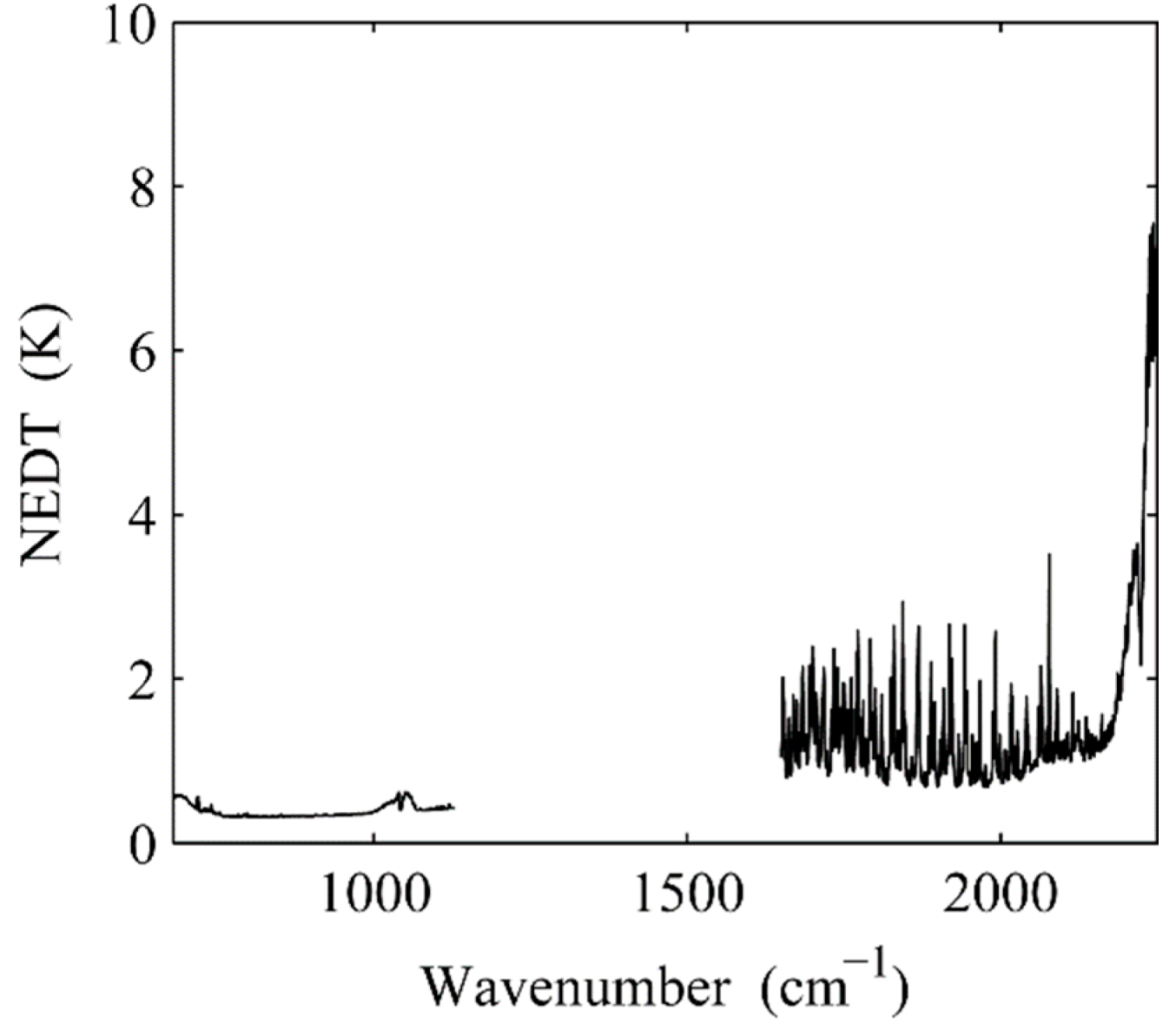
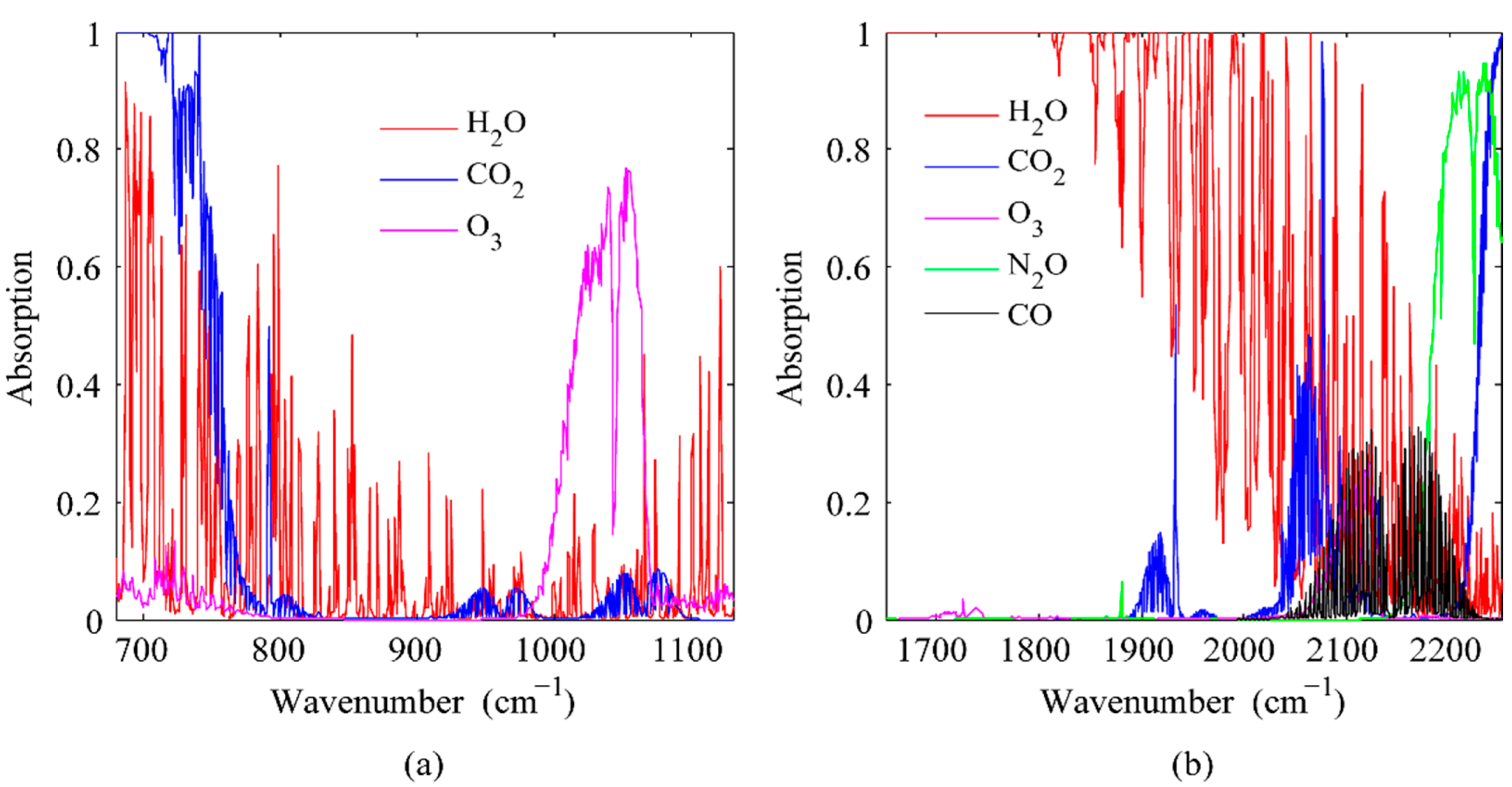



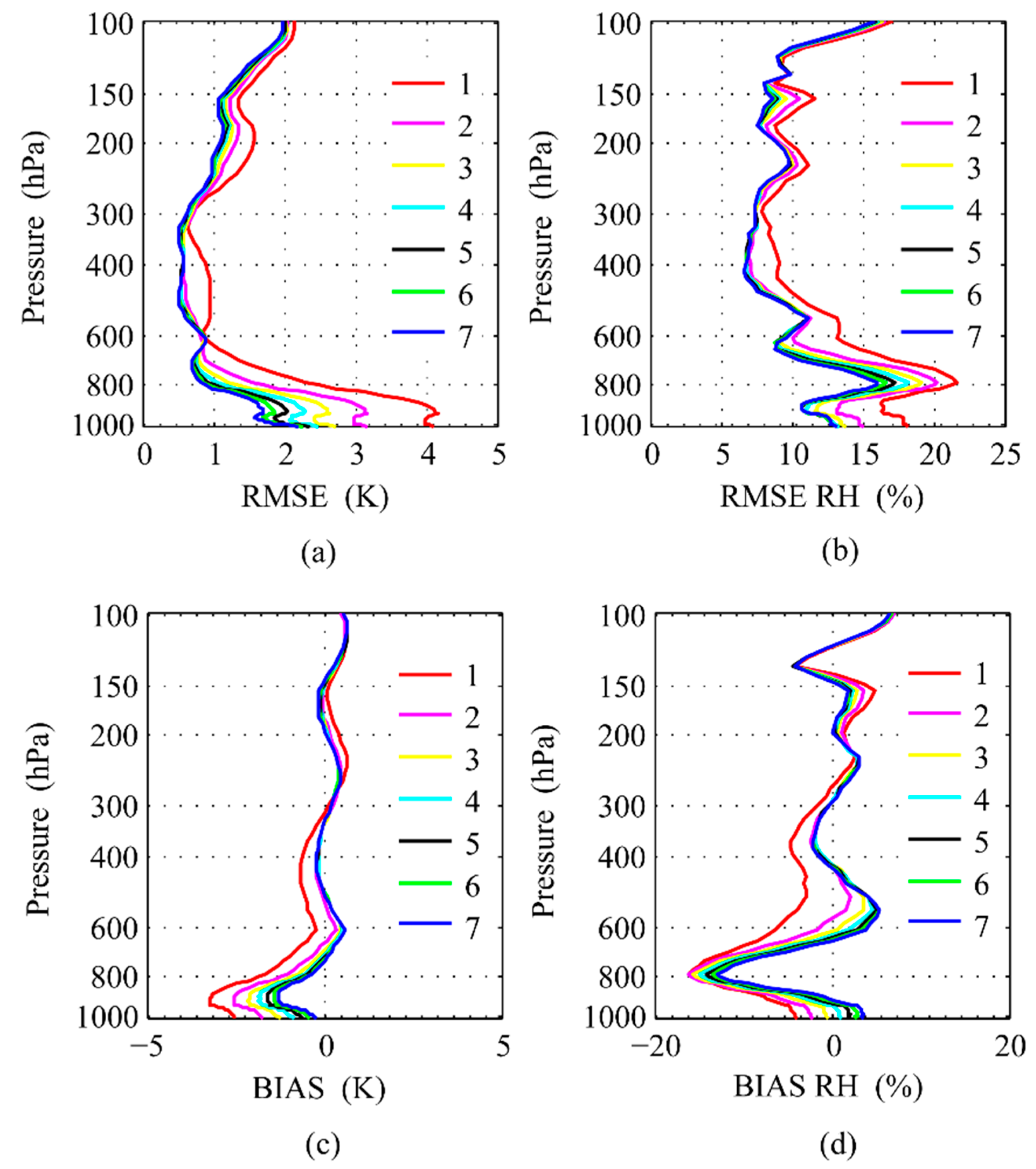
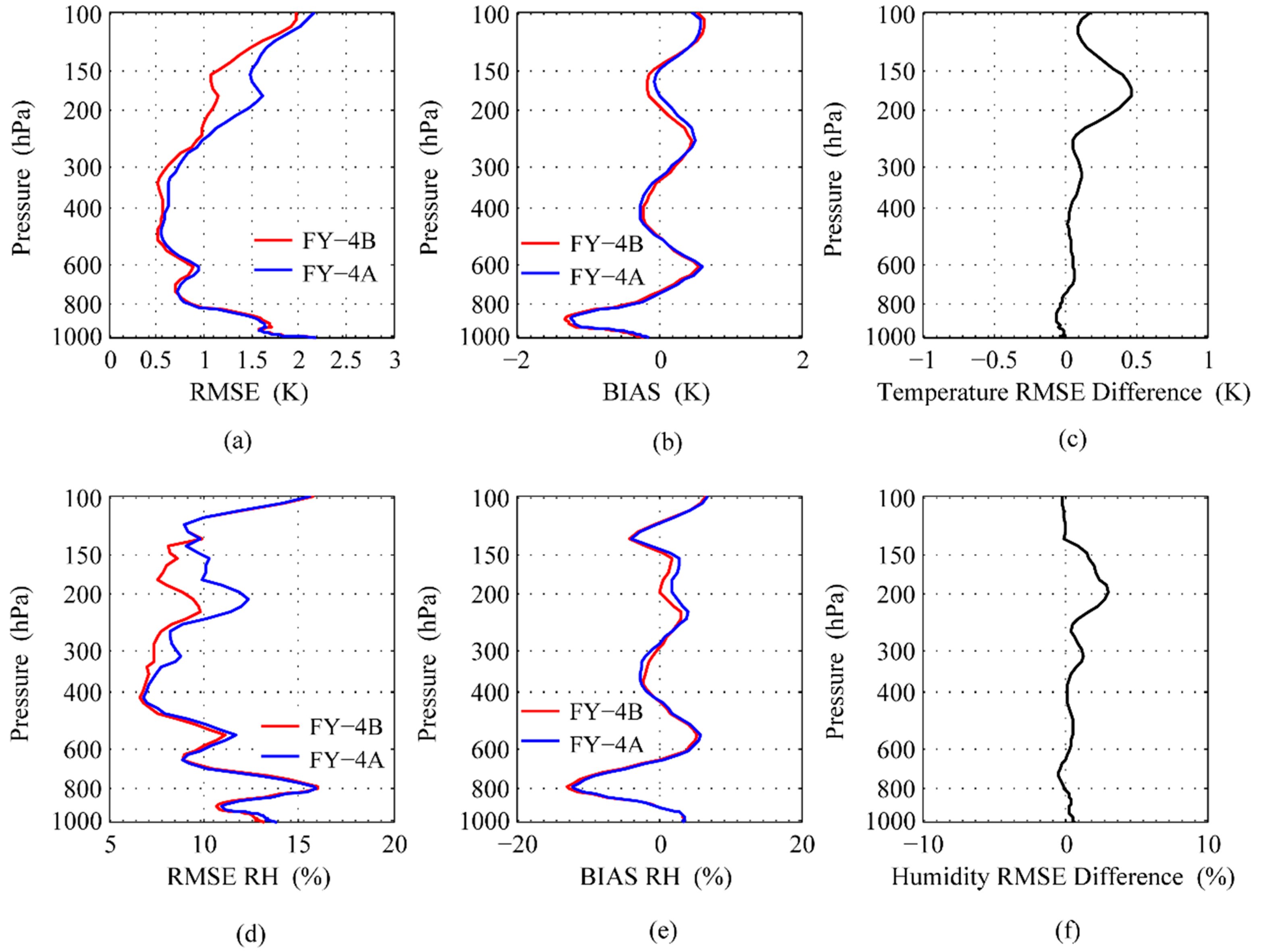
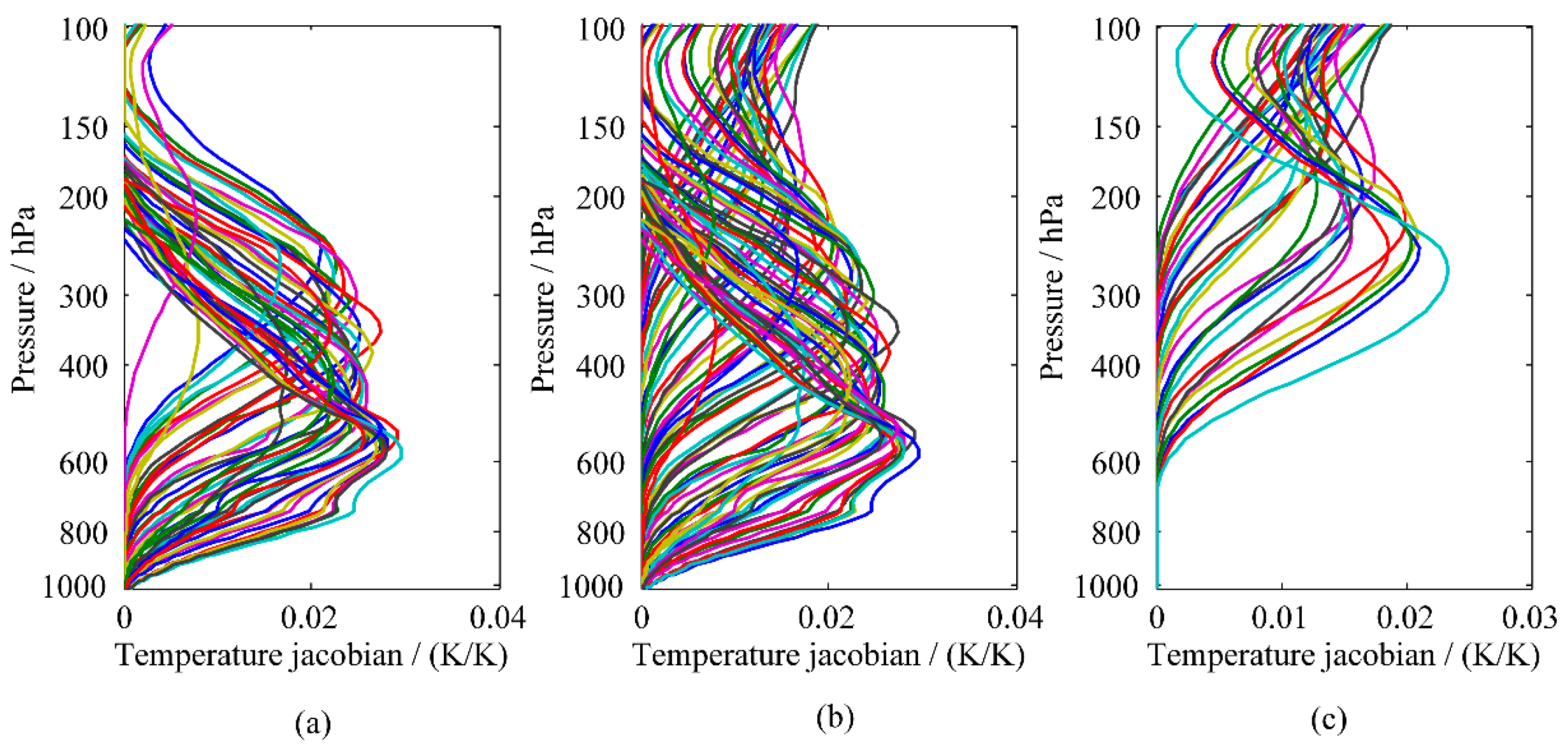


| Satellite | Instrument | Technique | Spectral Range/cm−1 | Spectral Resolution/cm−1 | Channels | Spatial Resolution /km |
|---|---|---|---|---|---|---|
| EOS-Aqua | AIRS | GS | 650–1135 1215–1615 2180–2665 | 0.5 1.2 2 | 2378 | 13 |
| MetOp | IASI | MI | 645–2760 | 0.5 | 8461 | 12 |
| MetOp | IASI-NG | MI | 645–2760 | 0.25 | 16922 | 12 |
| MTG | IRS | MI | 680–1210 1600–2250 | ~0.6 | 1960 | 4 |
| SNPP | CrIS | MI | 650–1095 1210–1750 2155–2550 | 0.625 1.25 2.5 | 1305 | 14 |
| FY-3D | HIRAS | MI | 667–1136 1210–1750 2155–2550 | 0.625 1.25 2.5 | 1343 | 16 |
| FY-4A | GIIRS | MI | 700–1130 1650–2250 | 0.625 | 1650 | 16 |
| FY-4B | GIIRS | MI | 680–1130 1650–2250 | 0.625 | 1682 | 12 |
| Parameters | FY-4A (R&D) | FY-4B (Operational) | ||||||
|---|---|---|---|---|---|---|---|---|
| Spectral Parameters(Normal mode) | Spectral range (cm−1) | Resolution | Channels | Spectral range (cm−1) | Resolution | Channels | ||
| LWIR | 700–1130 | 0.625 | 689 | LWIR | 680–1130 | 0.625 | 721 | |
| MWIR | 1650–2250 | 0.625 | 961 | MWIR | 1650–2250 | 0.625 | 961 | |
| VIS | 0.55–0.75 μm | -- | 1 | VIS | 0.55–0.75 μm | -- | 1 | |
| Spatial Resolution | LWIR/MWIR | 16 km SSP | LWIR/MWIR | 12 km SSP | ||||
| VIS | 2 km SSP | VIS | 1 km SSP | |||||
| Operational Mode | China area | 5000 × 5000 km2 | China area | 5000 × 5000 km2 | ||||
| Mesoscale area | 1000 × 1000 km2 | Mesoscale area | 1000 × 1000 km2 | |||||
| Temporal Resolution | China area | 60 min | China area | 45 min | ||||
| Mesoscale area | <0.5 h | Mesoscale area | 15 min | |||||
| Sensitivity (mW/m2sr cm−1) | LWIR | 0.5–1.1 | LWIR | <0.5 | ||||
| MWIR | 0.1–0.14 | MWIR | <0.1 | |||||
| VIS | S/N > 200 (ρ = 100%) | VIS | S/N > 200 (ρ = 100%) | |||||
| Calibration accuracy (radiation) | 1.5 k (3σ) | 0.7k (3σ) | ||||||
| Calibration accuracy (spectrum) | 10 ppm (3σ) | <10 ppm (3σ) | ||||||
| Quantization Bits | 13 | 13 | ||||||
| The Retrieval Number | FY-4A | FY-4B | ||||||
|---|---|---|---|---|---|---|---|---|
| Temperature | Humidity | Temperature | Humidity | |||||
| RMSE/K | BIAS/K | RMSE/% | BIAS/% | RMSE/K | BIAS/K | RMSE/% | BIAS/% | |
| 1 | 2.23 | −0.73 | 14.37 | −2.91 | 2.17 | −1.04 | 13.82 | −4.08 |
| 2 | 1.73 | −0.56 | 12.45 | −1.85 | 1.69 | −0.67 | 11.96 | −2.61 |
| 3 | 1.52 | −0.41 | 11.65 | −1.22 | 1.48 | −0.48 | 11.21 | −1.77 |
| 4 | 1.40 | −0.30 | 11.31 | −0.73 | 1.35 | −0.36 | 10.84 | −1.16 |
| 5 | 1.33 | −0.22 | 11.20 | −0.34 | 1.27 | −0.28 | 10.64 | −0.69 |
| 6 | 1.28 | −0.17 | 11.09 | −0.03 | 1.21 | −0.21 | 10.53 | −0.33 |
| 7 | 1.24 | −0.12 | 11.06 | 0.23 | 1.17 | −0.17 | 10.46 | −0.04 |
| Pressure/hPa | Temperature RMSE/K | Relative Humidity RMSE/% | ||
|---|---|---|---|---|
| FY-4A | FY-4B | FY-4A | FY-4B | |
| 104 | 2.10 | 1.98 | 14.26 | 14.25 |
| 141 | 1.56 | 1.29 | 9.05 | 8.10 |
| 180 | 1.61 | 1.15 | 9.93 | 7.55 |
| 216 | 1.22 | 1.00 | 11.96 | 9.71 |
| 259 | 0.92 | 0.87 | 8.21 | 7.73 |
| 296 | 0.75 | 0.64 | 8.54 | 7.35 |
| 351 | 0.62 | 0.53 | 7.51 | 7.08 |
| 398 | 0.62 | 0.58 | 6.98 | 6.83 |
| 506 | 0.56 | 0.53 | 10.10 | 9.58 |
| 609 | 0.95 | 0.89 | 9.87 | 9.53 |
| 711 | 0.73 | 0.70 | 11.57 | 11.49 |
| 846 | 1.38 | 1.38 | 13.54 | 13.18 |
| 975 | 1.64 | 1.64 | 13.16 | 12.63 |
| 1008 | 2.18 | 2.17 | 13.88 | 13.19 |
Publisher’s Note: MDPI stays neutral with regard to jurisdictional claims in published maps and institutional affiliations. |
© 2022 by the authors. Licensee MDPI, Basel, Switzerland. This article is an open access article distributed under the terms and conditions of the Creative Commons Attribution (CC BY) license (https://creativecommons.org/licenses/by/4.0/).
Share and Cite
Wang, S.; Lu, F.; Feng, Y. An Investigation of the Fengyun-4A/B GIIRS Performance on Temperature and Humidity Retrievals. Atmosphere 2022, 13, 1830. https://doi.org/10.3390/atmos13111830
Wang S, Lu F, Feng Y. An Investigation of the Fengyun-4A/B GIIRS Performance on Temperature and Humidity Retrievals. Atmosphere. 2022; 13(11):1830. https://doi.org/10.3390/atmos13111830
Chicago/Turabian StyleWang, Sufeng, Feng Lu, and Yutao Feng. 2022. "An Investigation of the Fengyun-4A/B GIIRS Performance on Temperature and Humidity Retrievals" Atmosphere 13, no. 11: 1830. https://doi.org/10.3390/atmos13111830
APA StyleWang, S., Lu, F., & Feng, Y. (2022). An Investigation of the Fengyun-4A/B GIIRS Performance on Temperature and Humidity Retrievals. Atmosphere, 13(11), 1830. https://doi.org/10.3390/atmos13111830





